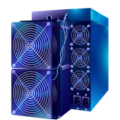iBeLink BM-K3
BM-K3 insights de rentabilité alimentés par des données en temps réel : Découvrez combien votre BM-K3 Vous pouvez gagner en utilisant notre calculateur avancé de mineur ASIC. Nous utilisons des données de récompense de minage en direct et prenons automatiquement en compte les coûts d'électricité, vous donnant un aperçu clair de vos retours potentiels quotidiens, mensuels et annuels.
Analyse de rentabilité
Ici, vous pouvez voir une analyse détaillée de la rentabilité des mineurs, mise à jour en temps réel.
| . | Revenu | Dépense | Profit |
|---|---|---|---|
|
Quotidien
|
$1.91 | $6.34 |
$-4.43
|
|
Mensuel
|
$57.18 | $190.08 |
$-132.90
|
|
Annuel
|
$695.69 | $2,312.64 |
$-1,616.95
|
À propos de la iBeLink BM-K3 (70TH/s)
En savoir plus sur cet miner ASIC, y compris ses spécifications, ses performances, sa consommation d'énergie et sa rentabilité.
The iBeLink BM-K3 presents itself as a purpose-built Kadena ASIC: a Blake2S miner delivering 70 terahashes per second while drawing 3,300 watts, which translates to an energy footprint of roughly 47.14 joules per terahash - a specification that frames both its raw potential and the operational calculus every miner must run; housed in a compact 128 x 201 x 402 mm chassis and weighing 6.6 kilograms, it pairs advanced cooling and secure remote management with an Ethernet interface for reliable network connectivity, operates within a 5–40 °C temperature window and 5–95% relative humidity range, and emits about 74 dB of noise, so placement, ventilation and sound isolation are practical considerations rather than afterthoughts. Technically precise and deliberately austere, the BM-K3 is designed for continuous, high-load environments where stable power delivery, surge protection and adequate airflow are non‑negotiable; miners should factor ambient temperature limits and acoustic output into site selection and consider vibration-damping surfaces to protect sensitive mounting points. From a planning perspective, use a miner profit calculator to translate hashrate and power draw into daily, monthly and yearly revenue projections while incorporating electricity rates, changing network difficulty and pool fees to model realistic returns over time - the tool’s ability to accept different rate inputs and currencies helps map profitability under multiple scenarios and highlight breakeven horizons. In short, the BM-K3 is a dense, efficient workhorse for operators targeting Kadena: its numbers demand disciplined infrastructure and constant monitoring, but when deployed within its environmental and electrical parameters it becomes a predictable element in a mining operation rather than a speculative gamble.
Découvrez quelles cryptomonnaies ce mineur peut extraire
Explorez les cryptomonnaies qui peuvent être minées en utilisant iBeLink BM-K3 (70TH/s), y compris la rentabilité détaillée.
Convertisseur de devises
Calculer les cryptomonnaies exploitables dans n'importe quelle devise.
| Pièce | Revenu/Jour | Profit/Jour |
|---|---|---|
|
$1.91
$
38.09

|
$-4.43
$
-88.23068369

|
Performance Historique de Minage
Voir les tendances de performance des iBeLink BM-K3 (70TH/s) sur des périodes hebdomadaires, mensuelles et annuelles.
Rentabilité historique
Voir les tendances historiques des revenus et des bénéfices pour ce mineur.
Kadena Générations de mineurs
Évolution du matériel de minage de cryptomonnaies au fil des ans, avec la génération actuelle mise en avant pour référence.
Génération 1
2 MineursGénération 2
2 MineursGénération 3
2 MineursGénération 4
2 MineursGénération 1
2 MineursGénération 2
2 MineursGénération 3
2 MineursGénération 4
2 MineursGénération 5
3 MineursGénération 6
3 MineursGénération 7
3 MineursPlus d'informations sur le
Apprenez-en davantage sur le iBeLink BM-K3 (70TH/s)
I confess that setting up the iBeLink BM-K3 felt less like acquiring a tool and more like accepting a duty: a purpose-built Blake2S ASIC that quietly promises 70 terahashes per second while drawing 3,300 watts, an arithmetic of power and consequence that works out to about 47.14 joules per terahash and leaves no room for casual deployment; its 128 x 201 x 402 millimeter chassis and 6.6 kilogram mass conceal a dense arrangement of 14 nm chips, high-static-pressure fans and a bespoke heatsink, plus an improved control board and firmware meant to steady operation and curb rejected shares, and an Ethernet port and web interface for remote oversight so the machine can be watched without intrusion. I say this plainly, without accusation: the miner performs best when the environment is organized - steady mains with surge suppression and proper grounding, a reliable power supply designed for high conversion efficiency, adequate ventilation or ducting to keep ambient temperatures between about 5 and 40 degrees Celsius, and humidity within a broad but realistic 5–95 percent window; ignore the 74 decibel noise level at your peril, or you will learn how quickly neighbors and conscience align on the subject of placement. In practice that means planning for acoustic mitigation, vibration-damping mounts, routine dust removal and thermal checks, scheduled firmware updates and pool selection to manage shares and payouts, and monitoring systems that log temperatures, hash rate and rejected shares so you can spot drift before it becomes failure. It is efficient, compact and capable, but it also insists on attention: continuous operation benefits from network redundancy, UPS or managed restart strategies, clear airflow paths, and an acceptance that electricity and difficulty shifts will change the ledger - use profitability models and scenario testing to translate raw hashrate into expectations over days, months and years, and treat the miner as an accountable asset rather than an anonymous black box, because when machines hum at this density, the lines between technical specification and ethical stewardship blur, and I admit I prefer to be guided by both measurement and a quiet sense of responsibility.
Où acheter ?
Fournisseurs fiables et disponibilité actuelle sur le marché, présentant des fournisseurs vérifiés proposant cet ASIC miner ainsi que leurs derniers prix et informations de stock.
Aucune offre disponible
Il n'y a actuellement aucune offre pour ce mineur. Veuillez vérifier plus tard.
Spécifications techniques
Des spécifications matérielles détaillées et des capacités de minage pour iBeLink BM-K3
Informations de base
Performance
Physical Dimensions
Additional Information
Cryptomonnaies minables

Information sur l'algorithme : Kadena
Apprenez-en davantage sur le Kadena algorithme et son fonctionnement.
Kadena est une fonction de hachage cryptographique qui sert de colonne vertébrale à Kadena mécanisme de consensus proof-of-work. Cet algorithme traite des données d'entrée de n'importe quelle longueur et produit une valeur de hachage fixe, garantissant la sécurité et l'intégrité du processus de minage.
Avis des utilisateurs
Voyez ce que les utilisateurs disent de ce mineur.
Aucun avis pour l’instant
Soyez le premier à évaluer ce mineur !
Questions Fréquemment Posées
Tout ce que vous devez savoir sur le iBeLink BM-K3
Quelle est l'efficacité de la iBeLink BM-K3 70TH/s?
Quel est le coût de l'électricité pour le iBeLink BM-K3 70TH/s (USD)?
Quelle puissance consomme le iBeLink BM-K3 70TH/s utiliser ?
Qui fabrique les BM-K3?
Quel est le hashrate de le iBeLink BM-K3?
Quelles cryptomonnaies peuvent être minées avec le iBeLink BM-K3 70TH/s?
 Kadena (KDA)
Kadena (KDA)
 Anglais
Anglais
 Allemand
Allemand
 Hongrois
Hongrois
 Néerlandais
Néerlandais
 Espagnol
Espagnol
 Français
Français
 Italien
Italien
 Tchèque
Tchèque
 Polonais
Polonais
 Grec
Grec


















